Characteristic low density and shear sensitivity of cross-linked chromatin containing polycomb complexes
- PMID: 15601863
- PMCID: PMC538796
- DOI: 10.1128/MCB.25.1.432-439.2005
Characteristic low density and shear sensitivity of cross-linked chromatin containing polycomb complexes
Abstract
Chromatin cross-linking is widely used for mapping the distribution of chromosomal proteins by immunoprecipitation, but our knowledge of the physical properties of chromatin complexes remains rudimentary. Density gradients have been long used to separate fragments of cross-linked chromatin with their bound proteins from free protein or free DNA. We find that the association of DNA fragments with very-high-molecular-weight protein complexes shifts their buoyant density to values much lower then that of bulk chromatin. We show that in a CsCl gradient, Polycomb response elements, promoters of active genes, and insulator or boundary elements are found at buoyant densities similar to those of free protein and are depleted from the bulk chromatin fractions. In these regions, the low density is associated with the presence of large protein complexes and with high sensitivity to sonication. Our results suggest that separation of different chromatin regions according to their buoyant density may bias chromatin immunoprecipitation results. Density centrifugation of cross-linked chromatin may provide a simple approach to investigate the properties of large chromatin complexes in vivo.
Figures
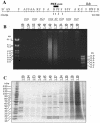
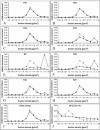
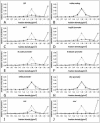
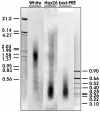

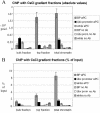
Similar articles
-
Two-step cross-linking method for identification of NF-kappaB gene network by chromatin immunoprecipitation.Biotechniques. 2005 Nov;39(5):715-25. doi: 10.2144/000112014. Biotechniques. 2005. PMID: 16315372
-
Mapping chromosomal proteins in vivo by formaldehyde-crosslinked-chromatin immunoprecipitation.Trends Biochem Sci. 2000 Mar;25(3):99-104. doi: 10.1016/s0968-0004(99)01535-2. Trends Biochem Sci. 2000. PMID: 10694875 Review.
-
The scaffold/matrix attachment region binding protein hnRNP-U (SAF-A) is directly bound to chromosomal DNA in vivo: a chemical cross-linking study.Biochemistry. 1997 Jul 8;36(27):8276-83. doi: 10.1021/bi970480f. Biochemistry. 1997. PMID: 9204873
-
Mapping Polycomb-repressed domains in the bithorax complex using in vivo formaldehyde cross-linked chromatin.Cell. 1993 Dec 17;75(6):1187-98. doi: 10.1016/0092-8674(93)90328-n. Cell. 1993. PMID: 7903220
-
Polycomb response elements and targeting of Polycomb group proteins in Drosophila.Curr Opin Genet Dev. 2006 Oct;16(5):476-84. doi: 10.1016/j.gde.2006.08.005. Epub 2006 Aug 17. Curr Opin Genet Dev. 2006. PMID: 16914306 Review.
Cited by
-
Optimal use of tandem biotin and V5 tags in ChIP assays.BMC Mol Biol. 2009 Feb 5;10:6. doi: 10.1186/1471-2199-10-6. BMC Mol Biol. 2009. PMID: 19196479 Free PMC article.
-
Predicting human nucleosome occupancy from primary sequence.PLoS Comput Biol. 2008 Aug 22;4(8):e1000134. doi: 10.1371/journal.pcbi.1000134. PLoS Comput Biol. 2008. PMID: 18725940 Free PMC article.
-
Surveying the epigenomic landscape, one base at a time.Genome Biol. 2012 Oct 22;13(10):250. doi: 10.1186/gb4051. Genome Biol. 2012. PMID: 23088423 Free PMC article. Review.
-
The Drosophila MSL complex activates the transcription of target genes.Genes Dev. 2005 Oct 1;19(19):2284-8. doi: 10.1101/gad.1343105. Genes Dev. 2005. PMID: 16204179 Free PMC article.
-
Histone modifications: from genome-wide maps to functional insights.Genome Biol. 2005;6(6):113. doi: 10.1186/gb-2005-6-6-113. Epub 2005 May 31. Genome Biol. 2005. PMID: 15960810 Free PMC article. Review.
References
-
- Bollag, D. M., M. D. Rozycki, and S. J. Edelstein. 1996. Protein methods. Wiley-Liss, Inc., New York, N.Y.
-
- Breiling, A., B. M. Turner, M. E. Bianchi, and V. Orlando. 2001. General transcription factors bind promoters repressed by Polycomb group proteins. Nature 412:651-655. - PubMed
-
- Brutlag, D., C. Schlehuber, and J. Bonner. 1969. Properties of formaldehyde-treated nucleohistone. Biochemistry 8:3214-3218. - PubMed
-
- Cavalli, G., V. Orlando, and R. Paro. 1999. Mapping DNA target sites of chromatin-associated proteins by formaldehyde cross-linking in Drosophila embryos, p. 20-30. In W. A. Bickmore (ed.), Chromosome structural analysis: a practical approach. Oxford University Press, Oxford, United Kingdom.
Publication types
MeSH terms
Substances
LinkOut - more resources
Full Text Sources
Molecular Biology Databases
